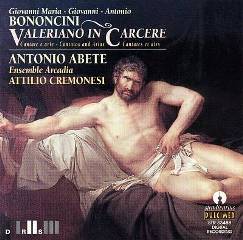Bononcini Family - Valeriano in Carcere (1999)
Bononcini Family - Valeriano in Carcere (1999)

1 Astarto, opera: Ouverture 2 Astarto, opera: Atto 1. Aria di Fenicio: Sě perirŕ e avrŕ dalle nostr'armi 3 Astarto, opera: Atto 2. Aria di Fenicio: Mi veggo solo e vinto 4 Astarto, opera: Atto 3. Aria di Fenicio: Disciolte dal piede 5 Valeriano in Carcere 6 La Decollazione di Giovanni Battista: Sinfonia 7 La Decollazione di Giovanni Battista: Parte 1. Aria di Erode: Tutto attento il sol mirai 8 Quattro Arie: L'interesse sol prevale 9 Quattro Arie: Non c'č affetto 10 Quattro Arie: L'amicizia si tradisce 11 Quattro Arie: Non si stimano che gli ori 12 La Maddalena ai Piedi di Cristo: Sinfonia. Parte 2. Recitativo e Aria di Christo 13 La Maddalena ai Piedi di Cristo: Recitativo: Tu che qual cerva 14 La Maddalena ai Piedi di Cristo: Aria: Il tuo foco a poco a poco 15 Ercole All'Inferno Antonio Abete – Bass Ensemble Arcadia Attilio Cremonesi – conductor
The Bononcini family were string players and composers with an established reputation. Giovanni Maria Bononcini (1642-78, the father) studied the violin and composition, and his own trio sonatas are considered important precursors of Corelli's op 1-4. His musical treatise - Musico prattico - circulated widely and influenced such later writers as J.G. Walther and Mattheson. He also left cantatas, a volume of madrigals and a later volume of trios.
Giovanni Battista Bononcini was born in Modena, Italy, in 1670, the eldest and most successful of three sons; he died Vienna in 1747.
Giovanni Battista trained as a cellist in Bologna, where he published two collections of trios (1685) and three of sinfonie (1685-7); he was a member of the Accademia Filarmonica, a musician at San Petronio (for which he composed two Lenten oratorios, 1687-8) and finally maestro di cappella at San Giovanni in Monte until 1689 - his four double-choir Masses, published in 1688 as op. 7, were composed for the services there.
From Bologna he went to Milan to take up a commission from the Duke of Modena, and then to Rome - via Bologna, where he played in Cardinal Pamphili's orchestra. While in the service of Filippo Colonna in Rome, Bononcini collaborated with the poet Silvio Stampiglia on six serenatas, an oratorio and five operas, of which the last, Il trionfo di Camilla, was the highlight of the 1696-7 Naples Carnival. By this time his operas were in production throughout Italy, and his opera Camilla was to be given 64 performances in London at the Theatre Royal, Drury Lane between 1706 and1709, becoming the first Italian opera to gain popularity on the English stage (in part because it was sung in translation by English singers).
He had been recruited in 1698 to the court of Leopold I in Vienna, where he became a particular favorite of the heir Joseph who acceded the throne in 1705. Stampiglia, along with Bononcini's younger brother Antonio Maria (1677-1726) - also a cellist in Pamphili's orchestra and an opera composer - soon joined him in Vienna. After the death of Emperor Joseph I in 1711, Bononcini left the Viennese court for Rome. Here he remained until 1719 when he was invited to London by the Earl of Burlington to become a composer for the Royal Academy of Music under Handel's direction.
His operatic reputation having preceded him, Bononcini was warmly received in London where Astarto opened the second season at the King's Theatre in the Haymarket late in 1720, outshining Handel's own operas. The following year he contributed the second act (the first and third were by fellow cellist Filippo Amadei and Handel) to Muzio Scevola. L'odio e l'amore followed a month later at the Haymarket Theatre. He spent the summer of 1723 in Paris where he was offered a position by the regent's mistress and, indeed, spent the following summer there, along with singers (including the famous Cuzzoni) from London.
Bononcini returned to London, accepting a position as director of the private concerts of the Duchess of Marlborough, a position he held until 1731. In 1727 his opera Astianatte was presented at the Haymarket. He maintained his connections in France, visiting again in 1731 and then moving to Paris in 1733, where his music (including the Laudate pueri for voices and orchestra) was performed at the Concert Spirituel. 1735 saw him in Lisbon and by the middle of the following year he had arrived in Vienna where he remained until his death a decade later. During that time two of his operas and an oratorio were performed; his last known work is a Te Deum, commissioned by the empress in 1741.
download: uploaded filecloudio anonfiles yandex 4shared solidfiles mediafire mega nornar








